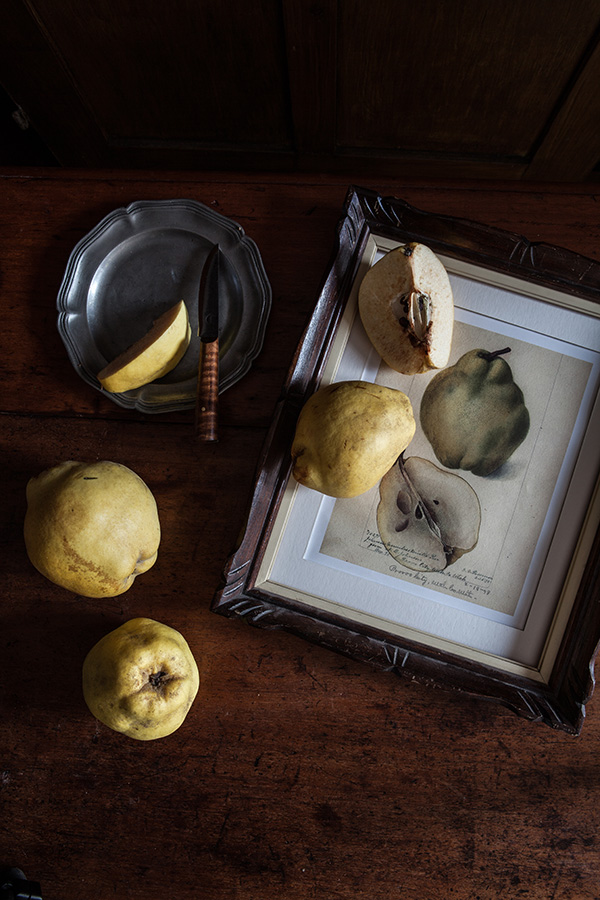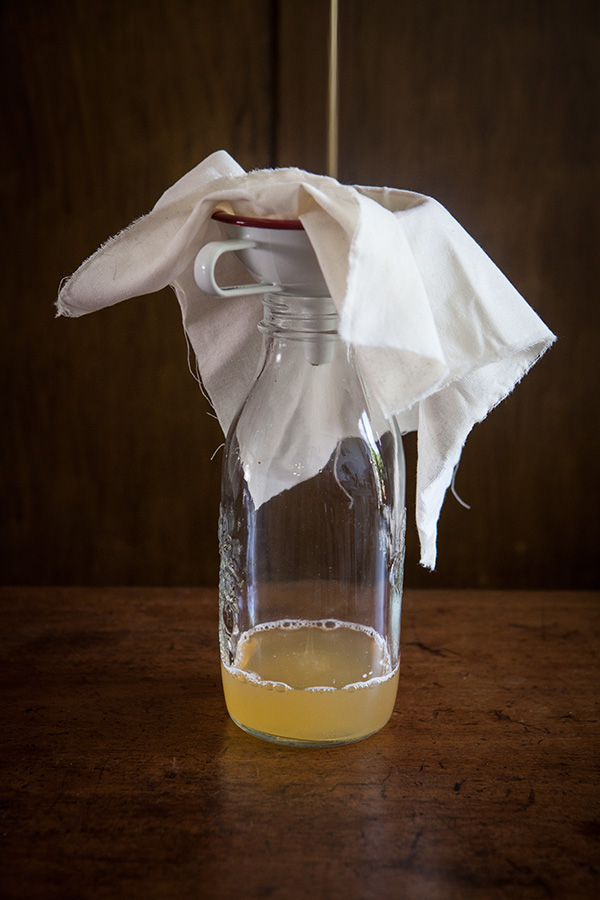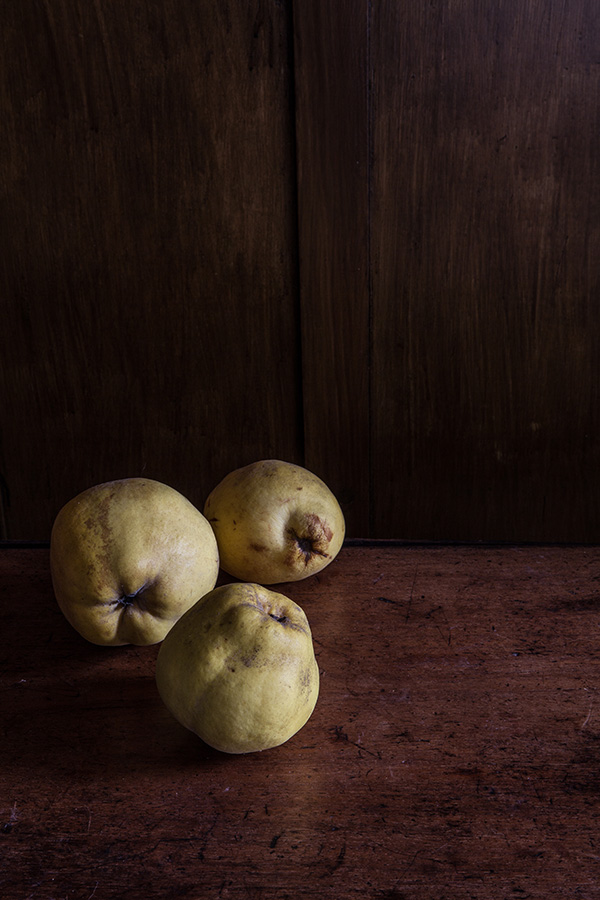 Quince really are a mystical fruit. They hang like lanterns from the trees, forcing the branches to bend down with their weight. One can not ignore their smell, how they fill your kitchen with that sweet incense-like scent. The smell far sweeter than they really are, because as far as fruits go, they are very tart. So tart that they are considered inedible raw.
Quince really are a mystical fruit. They hang like lanterns from the trees, forcing the branches to bend down with their weight. One can not ignore their smell, how they fill your kitchen with that sweet incense-like scent. The smell far sweeter than they really are, because as far as fruits go, they are very tart. So tart that they are considered inedible raw.
Recipes over time always require you to cook quinces, and cook them long and slow. Some authors claim you should never put spices with quinces but most instruct you to add cinnamon, cloves, peper and more sweet spices.
Quinces are responsible for the word marmalade as their Portuguese word is ‘marmelo’ and they were made into fruit cheeses named marmalades. The marmalades were served after dinner as a digestive and they were often prescribed by apothecaries to cure minor ailments.
The pear shaped yellow fruits were made into pies, preserved whole and in form of a syrup and they were also made into Ratafia. Ratafias were infused alcohols much like the Amaretto we know today. It could be made with apricot kernels, bitter almonds – which produce the original Amaretto, cherry kernels and cherries, and our beautiful quinces.
Ratafia of quinces was popular in the 18th century in England, and in the 17th and 18th in France. The following recipe is that of Vincent La Chapelle, the master cook to the fourth earl of Chesterfield, William IV, the Prince of Orange, John V of Portugal and even the mistress of Louis XV of France: Madamme de Pompadour.
Like with so many historical writers, he borrowed a lot of his recipes of another author, in this case the French Francois Massialot who published a book on court cookery and confectionery in 1692. These two gentlemen both share recipes for Quince Ratafia, but La Chapelle instructs us to bring the quince juice to a boil, while Massialot does not. They also use different spices, making the end result not the same drink at all.
You must have some Quinces, and rasp them with a Grater; all being grated, you must have a Piece of strong Cloth, put in a small handful, and squeese it with all your Might, that the Juice may come from it; when all is squeesed and you have all the Juice, put it in a Preserving pan, let it take just one single Boiling, and let it cool; being cooled, measure two Quarts of Juice and two Quarts of Brandy, Measure by Measure, and clarify some Sugar; to each two Quarts, ten Ounces of Sugar, a Piece of Cinnamon, four Cloves, and three or four Grains of white Pepper whole; stop up your Jug very close, put it aside for two or three Months, put it through a Straining-bag, until it come very clear, and put it up in Bottles flopped very close.
Vincent la Chapelle, The Modern Cook, London, 1733
In 1830 ‘The Cook’s Dictionary’ by Richard Dolby instructs us to leave the scrapings of quince for 24 hours until they start to ferment, then extract the juice and add it to spiced brandy. We’re not going to ferment the quince, I will try that next year as I just caught the last of the quinces of the year at the market. And I’m going to leave out the spices because I want to know how it tastes like without them, quince have such a delicate flavour.
What is your favourite quince recipe?
Quince Ratafia
What do you need
250 g quince juice
250 g sugar
700 ml vodka or Eau de vie
a strainer
a cloth or jelly bag
1 liter bottle
Method
As Quinces vary in size and juiciness, I can only give you the amount of juice needed.
In my case I used three large quinces, of which two had little juice so it does really depend.
The original recipe states to grate the quince and then put the grated flesh into a cloth which you have to squeeze to get all the juice out. I am not convinced this works very well and if it does it will be labour intensive. Do if you have a juicer, use that, if you have a blender, use that and strain very well.
Do remove the cores and pips but leave the skin on, just give it a good wash to remove the grey dewy coating quinces often have.
After you have juiced your quince, pour the juice in a saucepan and bring to a boil on a gentle flame.
Once it has boiled, take off the fire and leave to cool.
When cooled, line a strainer with a cloth or jelly bag and place on the bottle you are using.
Pour the juice in the cloth and continue to do so until all the juice is strained.
You need to do this as there might still be some sediment in your juice that you need to remove.
Now add the sugar, and then the alcohol, close the bottle and shake.
Shake the bottle every day the first week and once a week the following month.
Then leave to rest a couple of months and enjoy cold in a dainty glass.
You might also like
Ypocras – mulled wine
Sloe Gin
Hop brandy










Dear Regula, I get so happy to hear someone write about quinces, marmelos in Portuguese. During my teen years I lived in the country side (in Portugal) and we had a quince tree, the smell is something difficult to discribe. Every end of the Summer, when the quinces were ready we always made “marmelada”. I still make it today everytime I find quices in the market. I love a sandwich with marmelada and cheese.
Quince jelly is something very special too. My mom likes to bake them in the oven, just like apples, and springle a little bit of sugar before eating.
I do wish I had a quince tree, I only ever saw them growing for real one time when we were visiting a house we wanted to buy. They look so otherworldly. And indeed there is so much you can do with them.
I’ve made quince ratafia from Diana Henry’s recipe. I turns a beautiful golden colour and gets better with age. Lovely with sparkling wine or Champagne.
I made this one last year and it indeed has a beautiful colour, much like honey. And the fragrance is just amazing. I’ll try it with champagne or English sparkling wine in my case 😉 I am sure it will be fantastic!
Oh, that ratafia must be delightfully fragrant!
Cheers,
Rosa
It is! It only gets better!
I love quinces. They are so hard to find in the Netherlands but if I can get my hands on them I do love them poached. In a similar fashion to poaching regular pears but this sounds pretty cool to try too! I do have a juicer so if I find some quinces I will give it a go!
Are they? How weird, you have kale and we don’t, and I got quinces!
Especially the Turkish shops sell them, and the markets vendors who are Turkish and Maroccan, maybe you don’t have as much other cultures on your weekly market.
Hope you find some!
Hi!
I really like your blog.
I nominated you for the Liebster award!
Check it out > http://wp.me/pScge-9V
Kristina from http://www.britsandrusskies.com
Thank you so much xx
Dear Regula many thanks for sharing this quinces recipe. Have made similar drink with elderberries and vodka! Will certainly give it a try if I can lay my hands on quinces again. As Simone says very hard to get here. Three weeks ago I was lucky and made quinces jam with rooibos tea. One of my favourite recipes.
I hope you were able to find some quinces! It really is a lovely fragrant drink. Thanks for stopping by!